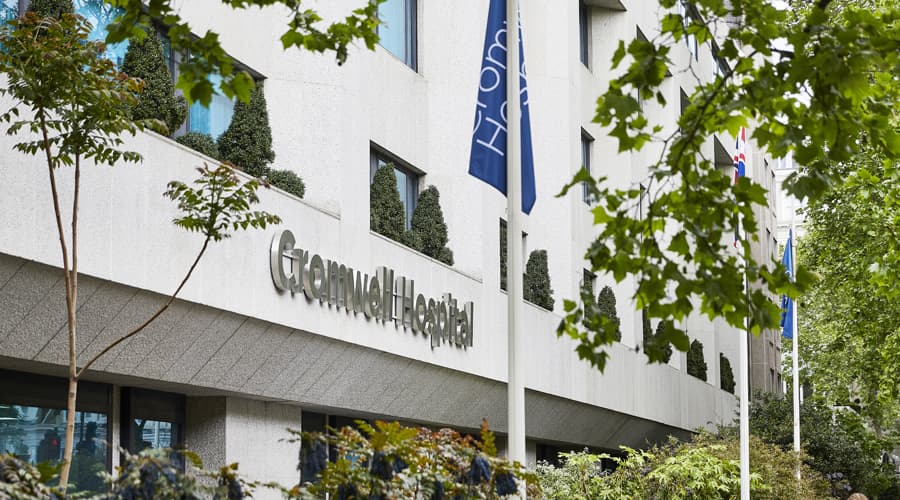Free flap surgery
Free flap surgery is a type of reconstructive surgery that involves the transfer of your own living tissue from a donor site to a recipient site.
Reviewed by Mr Alastair Fry, Consultant Oral and Maxillofacial Surgeon
At a glance
Who is it for?
People who require reconstructive or restorative surgery following tumour removal, usually around the jaw or mouth.
What's involved?
A piece of living donor tissue is taken from the patient's own body and used to rebuild the affected recipient site.
What's recovery like?
One to two weeks in hospital, followed by several months of recovery.
What is free flap surgery?
Free flap surgery is a type of reconstructive surgery that is often used to restore the function and appearance of the head and neck area following tumour removal. There are different types of free flap surgery, such as fibular flap, radial forearm flap, and more.
To prevent a head and neck tumour from growing back, the healthy tissues surrounding the tumour must also be removed. Depending on the location of the tumour, this can leave many patients requiring reconstructive surgery.
A 'free flap' is a piece of your own living tissue, which is taken from a donor site on your body (usually the thigh) and transferred to the recipient site.
Free flap surgery is a highly technical and complex surgery that must be carried out by a very experienced surgeon. This type of surgery can take up to four hours to complete.
Sometimes, free flap surgery is carried out at the same time as a tumour removal – usually when the jaw requires immediate reconstruction to restore its appearance and function. One surgeon will work on removing the tumour, while another surgeon will simultaneously work on harvesting the tissue from the donor site.
Cromwell Hospital performs more complex head and neck surgery with microvascular reconstruction than any other private hospital in the UK, with one of the highest success rates of anywhere in the world.
A radial forearm flap uses skin from the forearm, along with the radial artery and vein. The skin in this area is thin and flexible, which makes it useful for reconstructing the soft tissues of the mouth, such as the tongue, cheek lining, and floor of the mouth.
During the procedure, the skin and accompanying vessels are taken from just above the wrist. The site is closed with stitches, with an additional skin graft used to repair the wound near the wrist if necessary.
An antero-lateral thigh flap involves taking skin, fat, fascia and muscle from the side of the thigh. This flap is useful for when a large amount of skin is required, to repair larger defects of the mouth, head or neck.
This type of flap tends to heal well and does not usually require a skin graft.
The fibula is a bone located in the lower leg and is often used to reconstruct the jaw following cancer surgery. Patients can function normally without this bone, as the end parts – which provide stability to the ankle and knee – are preserved.
Fibular flap surgery is often carried out alongside cancer surgery, so that the jaw can be reconstructed immediately. A cut is made along the lower leg to remove the bone and its accompanying blood vessels. A skin graft is then applied to allow the site to heal.
A deep circumflex iliac artery (DCIA) flap is taken from the hip bone for use in reconstructing the jaw and teeth.
DCIA flap surgery is usually carried out alongside cancer surgery to provide immediate jaw reconstruction. A cut is made a few centimetres above the hip to remove a portion of the bone. Once the flap is removed, a mesh repair is used to mend the site.
A scapular is another term for the shoulder blade. In scapular flap surgery, the donor tissue is taken from the outer edge of the shoulder blade. This particular site is used because of the good quality of the bones and blood vessels making it reliable and the donor site has remarkably low side effects
During surgery, the patient is positioned lying down with their arm out so that the surgeon can create an incision below the armpit, which extends downwards. After the bone, blood vessels and any muscle are removed, the site is then stitched closed.
Recovery after free flap surgery
Recovery from free flap surgery depends on the location of the donor site. Flaps taken from the leg or hip usually require a longer recovery time, with physiotherapy used to restore normal movement.
Cromwell Hospital provides a full range of specialist rehabilitative services for head and neck patients who have had reconstructive surgery, including physiotherapy, speech and language therapy, cancer counselling, dietary advice, oral medicine, and further surgery if necessary.
During your recovery, you will receive regular support from our dedicated head and neck team, which includes a clinical nurse specialist, dietitians, and speech and language therapists.
Paying for your treatment
We welcome both self-paying and insured patients.
Self-pay patients
We offer several ways for patients to self-pay, including pay-as-you-go and self-pay packages.
Insured patients
At Cromwell Hospital, we accept private health insurance from most major providers, including AXA, Aviva, Bupa, and Vitality.
Our locations

Book an appointment today
Our telephone lines are open 8am to 8pm Monday to Friday and 8am to 2pm Saturdays.
Alternatively, fill out our appointment request form and we'll be in touch shortly.
Please note - regrettably we are unable to answer specific medical questions or offer medical advice via email or telephone.
